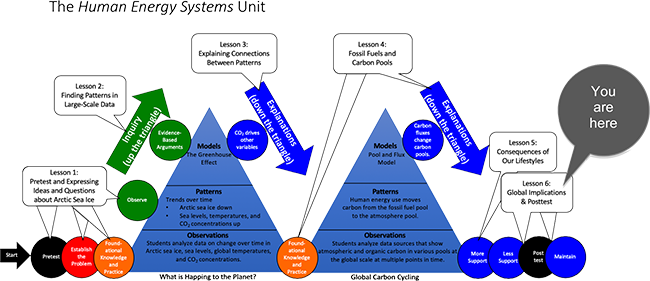Transformations in Matter and Energy Carbon TIME is an NSF-funded partnership led by Michigan State University
Human Energy Systems | Lesson 6 - Global Implications & Posttest
Overview
Students consider the impacts that rising carbon dioxide levels have on the Earth’s systems, discuss uncertainty in climate models and predictions, and consider the future of Earth’s systems given different CO2 emissions scenarios.
Guiding Question
What does increasing CO2 in the atmosphere mean for the future of the planet?
Activities in this Lesson
- Activity 6.1: Using Models to Predict Future Conditions (50 min)
- Activity 6.2: How Our Decisions Affect Earth’s Future (30 min)
- Activity 6.3: Human Energy Systems Unit Posttest (20 min)
Unit Map

Target Student Performance
|
Activity |
Target Performance |
|
|
|
|---|---|
|
Activity 6.1 Using Models to Predict Future Conditions (50 min) |
Students use the online Very, Very Simple Climate Model to make predictions about future atmospheric CO2 concentrations and global temperatures based on CO2 emissions scenarios. |
|
Activity 6.2 How Our Decisions Affect Earth’s Future (30 min) |
Students use graphs of projections from computer models to consider the impacts of increasing atmospheric CO2 on Earth’s systems and on living things. |
|
Activity 6.3: Human Energy Systems Unit Posttest (20 min) |
Students show their initial proficiencies for the overall unit goals: 1. Questioning, investigating, and explaining how the Earth’s climate is changing 2. Explaining and predicting how carbon cycles and energy flows in Earth systems. |
NGSS Performance Expectations
High School
- Ecosystems: Interactions, Energy, and Dynamics. HS-LS2-5. Develop a model to illustrate the role of photosynthesis and cellular respiration in the cycling of carbon among the biosphere, atmosphere, hydrosphere, and geosphere.
- Earth and Human Activity. HS-ESS3-6. Use a computational representation to illustrate the relationships among Earth systems and how those relationships are being modified due to human activity.
- Ecosystems: Interactions, Energy, and Dynamics. HS-LS2-7. Design, evaluate, and refine a solution for reducing the impacts of human activities on the environment and biodiversity.
- Earth’s Systems. HS-ESS2-2. Analyze geoscience data to make the claim that one change to Earth’s surface can create feedbacks that cause changes to other Earth systems.
- Weather and Climate. HS-ESS2-4. Use a model to describe how variations in the flow of energy into and out of Earth’s systems result in changes in climate.
- Earth and Human Activity. HS-ESS3-5. Analyze geoscience data and the results from global climate models to make an evidence-based forecast of the current rate of global or regional climate change and associated future impacts to Earth systems.
Middle School
- Human Impacts. MS-ESS3-4. Construct an argument supported by evidence for how increases in human population and per-capital consumption of natural resources impact Earth's systems.
- Earth and Human Activity. MS-ESS3-3. Apply scientific principles to design a method for monitoring and minimizing a human impact on the environment.
- Earth and Human Activity. MS-ESS3-5. Ask questions to clarify evidence of the factors that have caused the rise in global temperatures over the past century.

 Download PDF of Lesson 6 Teacher's Guide
Download PDF of Lesson 6 Teacher's Guide